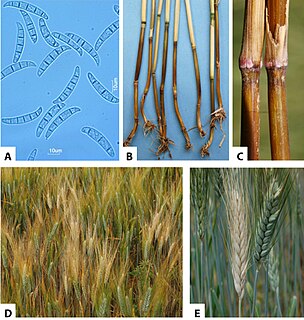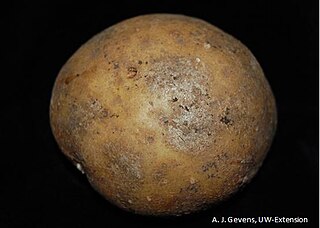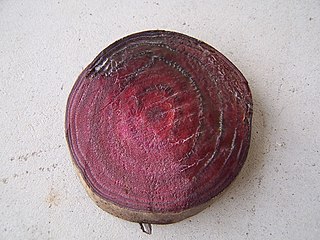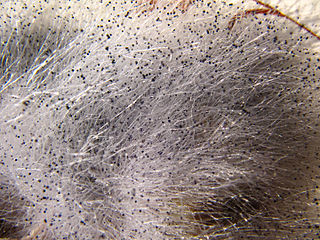Related Research Articles

The sweet potato or sweetpotato is a dicotyledonous plant that belongs to the bindweed or morning glory family, Convolvulaceae. Its large, starchy, sweet-tasting, tuberous roots are a root vegetable. The young leaves and shoots are sometimes eaten as greens. The sweet potato is commonly thought to be a type of potato but does not belong to the nightshade family, Solanaceae, but both families belong to the same taxonomic order, the Solanales. The sweet potato, especially the orange variety, is often called a "yam" in parts of North America, but is botanically very distinct from true yams.

Passiflora edulis or passion fruit is a vine species of passion flower native to southern Brazil through Paraguay and northern Argentina. It is cultivated commercially in tropical and subtropical areas for its sweet, seedy fruit, commonly called passion fruit. The fruit is a pepo, a type of berry, round to oval, either yellow or dark purple at maturity, with a soft to firm, juicy interior filled with numerous seeds. The fruit is both eaten and juiced, the juice often added to other fruit juices to enhance aroma.

Rhizopus is a genus of common saprophytic fungi on plants and specialized parasites on animals. They are found in a wide variety of organic substances , including "mature fruits and vegetables", jellies, syrups, leather, bread, peanuts, and tobacco. They are multicellular. Some Rhizopus species are opportunistic agents of human zygomycosis and can be fatal. Rhizopus infections may also be a complication of diabetic ketoacidosis. This widespread genus includes at least eight species.

Fusarium culmorum is a fungal plant pathogen and the causal agent of seedling blight, foot rot, ear blight, stalk rot, common root rot and other diseases of cereals, grasses, and a wide variety of monocots and dicots. In coastal dunegrass, F. culmorum is a nonpathogenic symbiont conferring both salt and drought tolerance to the plant.
Phytophthora nicotianae or black shank is an oomycete belonging to the order Peronosprales and family Peronosporaceae.
Phytophthora erythroseptica—also known as pink rot along with several other species of Phytophthora—is a plant pathogen. It infects potatoes causing their tubers to turn pink and damages leaves. It also infects tulips (Tulipa) damaging their leaves and shoots.
Rotylenchulus reniformis, the reniform nematode, is a species of parasitic nematode of plants with a worldwide distribution in the tropical and subtropical regions.

Fusarium solani is a species complex of at least 26 closely related filamentous fungi in the division Ascomycota, family Nectriaceae. It is the anamorph of Nectria haematococca. It is a common soil fungus and colonist of plant materials. Fusarium solani is implicated in plant disease as well as human disease notably infection of the cornea of the eye.

Silver scurf is a plant disease that is caused by the plant pathogen Helminthosporium solani. Silver scurf is a blemish disease, meaning the effect it has on tubers is mostly cosmetic and affects “fresh market, processing and seed tuber potatoes." There are some reports of it affecting development, meaning growth and tuber yield. This is caused by light brown lesions, which in turn change the permeability of tuber skin and then it causes tuber shrinkage and water loss, which finally causes weight loss. The disease has become economically important because silver scurf affected potatoes for processing and direct consumption have been rejected by the industry. The disease cycle can be divided into two stages: field and storage. It is mainly a seed borne disease and the primary source of inoculum is mainly infected potato seed tubers. Symptoms develop and worsen in storage because the conditions are conducive to sporulation. The ideal conditions for the spread of this disease are high temperatures and high humidity. There are also many cultural practices that favor spread and development. Luckily, there are multiple ways to help control the disease.
Bacterial soft rots are caused by several types of bacteria, but most commonly by species of gram-negative bacteria, Erwinia, Pectobacterium, and Pseudomonas. It is a destructive disease of fruits, vegetables, and ornamentals found worldwide, and affects genera from nearly all the plant families. The bacteria mainly attack the fleshy storage organs of their hosts, but they also affect succulent buds, stems, and petiole tissues. With the aid of special enzymes, the plant is turned into a liquidy mush in order for the bacteria to consume the plant cell's nutrients. Disease spread can be caused by simple physical interaction between infected and healthy tissues during storage or transit. The disease can also be spread by insects. Control of the disease is not always very effective, but sanitary practices in production, storing, and processing are something that can be done in order to slow the spread of the disease and protect yields.
Alturas is a potato variety released in 2002 by the USDA-ARS and the Agricultural Experiment Stations of Idaho, Oregon, and Washington and it is under plant variety protection. It is a processing potato that has cold-sweetening resistance, so it can be processed into French fries directly out of storage and other frozen potato products.
Fusarium dry rot is one of the most common potato diseases. It is caused by fungi in the genus Fusarium. This fungi causes a variety of colored rots in potatoes. This pathogen, while having both a sexual and asexual form, stays in an asexual cycle due to the way it spreads. Preferring warmer climates, it is not uncommon to find this pathogen in the northern United States where it has been reported to affect yield as much as 60%.

Beet vascular necrosis and rot is a soft rot disease caused by the bacterium Pectobacterium carotovorum subsp. betavasculorum, which has also been known as Pectobacterium betavasculorum and Erwinia carotovora subsp. betavasculorum. It was classified in the genus Erwinia until genetic evidence suggested that it belongs to its own group; however, the name Erwinia is still in use. As such, the disease is sometimes called Erwinia rot today. It is a very destructive disease that has been reported across the United States as well as in Egypt. Symptoms include wilting and black streaks on the leaves and petioles. It is usually not fatal to the plant, but in severe cases the beets will become hollowed and unmarketable. The bacteria is a generalist species which rots beets and other plants by secreting digestive enzymes that break down the cell wall and parenchyma tissues. The bacteria thrive in warm and wet conditions, but cannot survive long in fallow soil. However, it is able to persist for long periods of time in the rhizosphere of weeds and non-host crops. While it is difficult to eradicate, there are cultural practices that can be used to control the spread of the disease, such as avoiding injury to the plants and reducing or eliminating application of nitrogen fertilizer.

Blackleg is a plant disease of potato caused by pectolytic bacteria that can result in stunting, wilting, chlorosis of leaves, necrosis of several tissues, a decline in yield, and at times the death of the potato plant. The term "blackleg" originates from the typical blackening and decay of the lower stem portion, or "leg", of the plant.
The sweet potato is a very important crop for subsistence farmers in Africa and other developing countries. Due to its relatively short growing period, tolerance to drought and high yield from poor soils, it is used as a famine reserve for many of these households. However, it is a highly perishable food source that is susceptible to destruction by microorganisms, metabolic spoilage, physical destruction and pests. As such they are not generally stored for extended periods of time following harvest. This is a major barrier for the optimal use of the crop and causes a lot of waste.

Penicillium digitatum (/ˌpɛnɪˈsɪlɪəm/digitatum/) is a mesophilic fungus found in the soil of citrus-producing areas. It is a major source of post-harvest decay in fruits and is responsible for the widespread post-harvest disease in Citrus fruit known as green rot or green mould.In nature, this necrotrophic wound pathogen grows in filaments and reproduces asexually through the production of conidiophores. However, P. digitatum can also be cultivated in the laboratory setting. Alongside its pathogenic life cycle, P. digitatum is also involved in other human, animal and plant interactions and is currently being used in the production of immunologically based mycological detection assays for the food industry.

Rhizopus oryzae is a filamentous heterothallic microfungus that occurs as a saprotroph in soil, dung, and rotting vegetation. This species is very similar to Rhizopus stolonifer, but it can be distinguished by its smaller sporangia and air-dispersed sporangiospores. It differs from R. oligosporus and R. microsporus by its larger columellae and sporangiospores. R. oryzae is used economically in the production of the enzymes, glucoamylase and lipase, in the synthesis of organic acids, and in various fermented foods. The many strains of R. oryzae produce a wide range of enzymes such as carbohydrate digesting enzymes and polymers along with a number of organic acids, ethanol and esters giving it useful properties within the food industries, bio-diesel production, and pharmaceutical industries. It is also an opportunistic pathogen of humans causing mucormycosis.

Rhizopus stolonifer is commonly known as black bread mold. It is a member of Zygomycota and considered the most important species in the genus Rhizopus. It is one of the most common fungi in the world and has a global distribution although it is most commonly found in tropical and subtropical regions. It is a common agent of decomposition of stored foods. Like other members of the genus Rhizopus, R. stolonifer grows rapidly, mostly in indoor environments.
References
- ↑ Harter, L.L., Weimer, J.L, and Adams, J.M.R. 1918. Sweet-potato storage rots. Journal of Agricultural Research 15:337-368.
- 1 2 Clark, C.A. and Moyer, J.W. 1988. Compendium of sweet potato diseases. APS Press, St. Paul, MN. 74pp.
- ↑ Ceponis, M.J. and Butterfield, J.E. 1974. Retail and consumer losses in sweet potatoes marketed in metropolitan New York. HortScience 9:393-394.
- ↑ Farr, D.F., Rossman, A.Y., Palm, M.E., & McCray, E.B. (n.d.). Fungal Databases, Systematic Botany & Mycology Laboratory, ARS, USDA. Retrieved May 3, 2007, from "Archived copy". Archived from the original on 2007-01-30. Retrieved 2007-01-30.CS1 maint: archived copy as title (link).
- ↑ Lunn, J.A. 1977. Rhizopus stolonifer. CMI descriptions of pathogenic fungi and bacteria. No. 524. Kew, Surrey, England: Commonwealth Mycological Institute. 2pp.
- ↑ Halstead, B.D. 1890. Some fungous diseases of the sweet potato. New Jersey Agricultural Experiment Station. Bulletin 76.
- ↑ Clark, Christopher A.; Ferrin, Donald M.; Smith, Tara P.; Holmes, Gerald J. (2013-01-01). Compendium of Sweetpotato Diseases, Pests, and Disorders, Second Edition. Diseases and Pests Compendium Series. The American Phytopathological Society. doi:10.1094/9780890544952. ISBN 978-0-89054-495-2.
- ↑ Lauritzen, J.I. 1935. Factors affecting infection and decay of sweet potatoes by certain storage rot fungi. Journal of Agricultural Research 50:285-329.
- 1 2 Srivastava, D.N. and Walker, J.C. 1959. Mechanisms of infection of sweet potato roots by Rhizopus stolonifer. Phytopathology 49(7):400-406.
- ↑ Clark, C.A. and Hoy, M.W. 1994. Identification of resistance in sweetpotato to Rhizopus soft rot using two inoculation methods. Plant Disease 78:1078–1082.
- ↑ Holmes, G.J. and Stange, R.R. 2002. Influence of wound type and storage duration on susceptibility of sweetpotatoes to Rhizopus soft rot. Plant Disease 86:345-348.
- ↑ Nelson, Scot (February 2009). "Rhizopus Soft Rot of Sweetpotato" (PDF). University of Hawai'i.
- ↑ Rolston, L.H., Clark, C.A., Cannon, J.M., Randle, W.M., Riley, E.G., Wilson, P.W. and Robbins, M.L. 1987. Beauregard Sweet-potato. HortScience 22(6):1338–1339.
- ↑ Kushman, L.J. 1975. Effect of injury and relative humidity on weight and volume loss of sweet potatoes during curing and storage. HortScience 10:275-277.
- ↑ Weimer, J.L. and Harter, L.L. 1921. Wound-cork formation in the sweet potato. Journal of Agricultural Research 21:637-647.
- ↑ Edmunds, Brooke A.; Holmes, Gerald J. (2009-02-06). "Evaluation of Alternative Decay Control Products for Control of Postharvest Rhizopus Soft Rot of Sweetpotatoes". Plant Health Progress. 10 (1): 26. doi:10.1094/PHP-2009-0206-01-RS. ISSN 1535-1025.